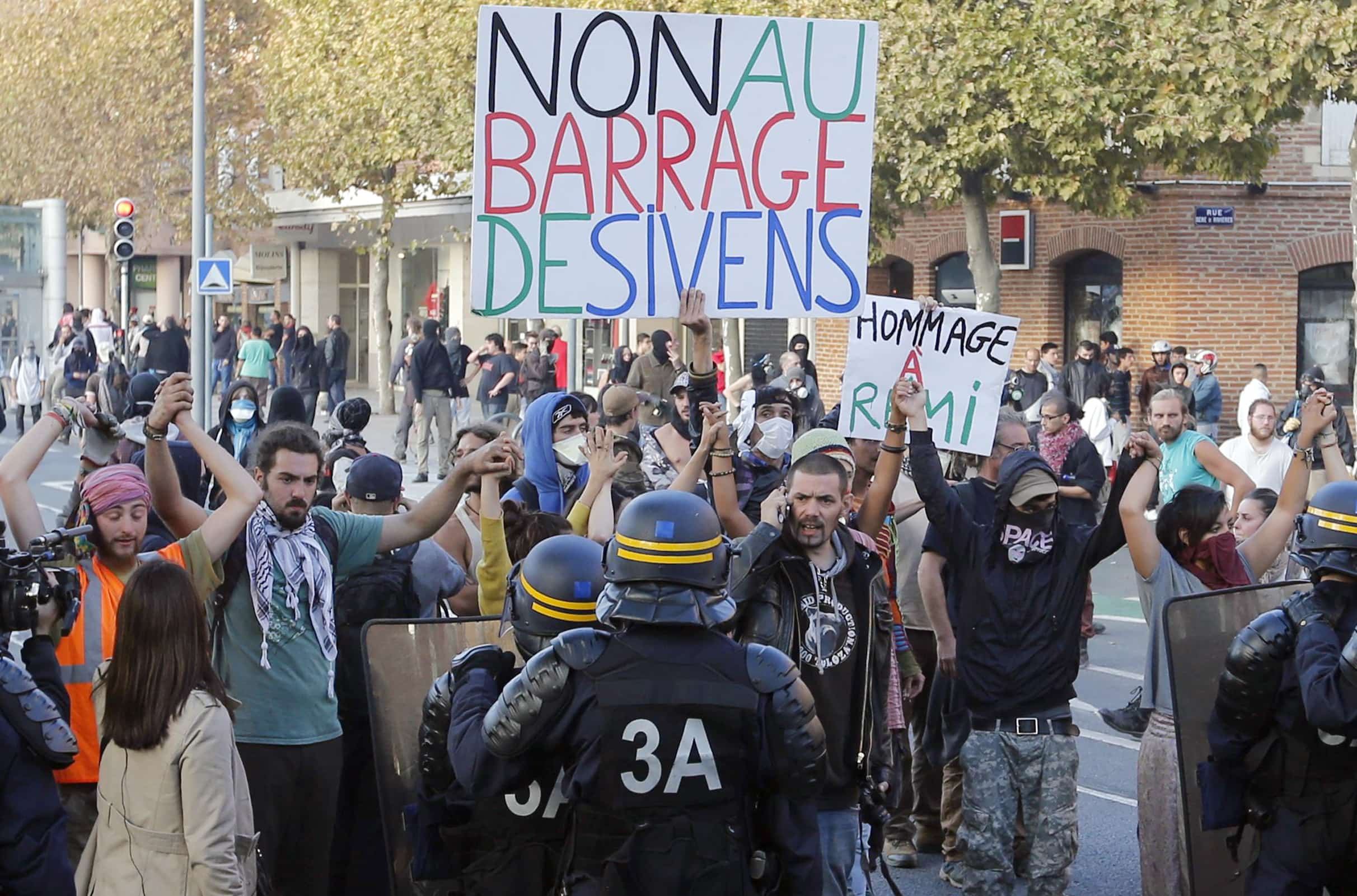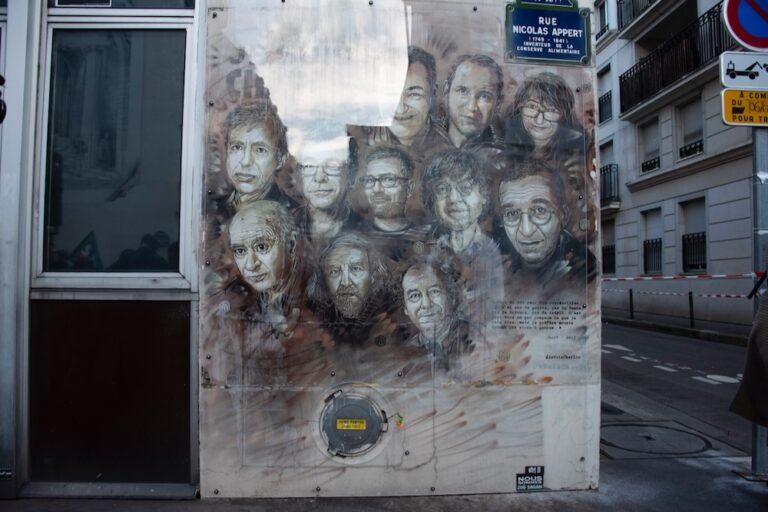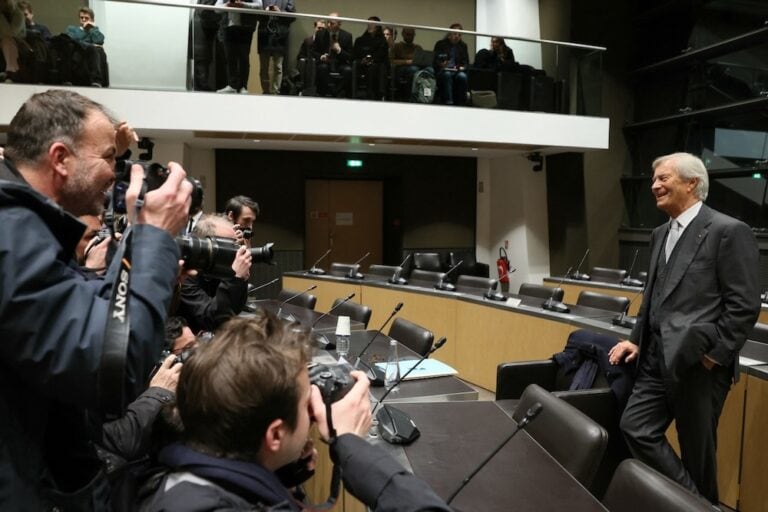Violence against journalists is becoming more and more common at all kinds of demonstrations in France, including the "Manif pour Tous" protests against same-sex marriage and the recent protests against the proposed Sivens Dam in the southern department of Tarn.
This statement was originally published on rsf.org on 14 November 2014.
Violence against journalists is becoming more and more common at all kinds of demonstrations in France, including the “Manif pour Tous” protests against same-sex marriage and the recent protests against the proposed Sivens Dam in the southern department of Tarn. Journalists have been telling Reporters Without Borders about the difficulties they increasingly encounter while trying to cover protests and the hostility to which they are exposed.
Tension between reporters and demonstrators is escalating at the Sivens Dam protests. Fearing for his safety, freelance reporter Eric Bouvet had to flee an event organized on 2 November in honour of Rémi Fraisse, a demonstrator killed at the dam site on 26 October. Demonstrators were circulating a photo of Bouvet along with claims that he was a police infiltrator – a situation indicative of the level of tension and incomprehension between protesters and journalists. Journalists have been prevented from taking photos and doing live TV reports from Albi and Lisle-sur-Tarn, two towns near the dam project, and in particular from the so-called “ZAD” (Zone to Defend), where the dam’s opponents have established a camp. Two journalists with the newspaper La Voix du Nord were deliberately attacked during a demonstration 900 km to the north, in Lille, on 27 October in protest against Fraisse’s death. “As soon as our photographer pulled out his camera, demonstrators grabbed him and sprayed him with a pepper spray at close range, aiming at his eyes,” deputy editor Pierre Mauchamp told Reporters Without Borders, adding that the protesters were above all targeting photographers.
Grégoire Souchay, a reporter with the Reporterre specialist news site who has been covering the opposition to the Sivens Dam, said protesters do not want to be photographed or filmed, and do not trust the media. The arrival of lots of reporters, including TV crews at the start of this month, after Fraisse’s death, exacerbated the tension, with demonstrators accusing the “mainstream media” of opposing the values they defend. Using websites and social networks, the demonstrators are trying to provide their own alternative coverage of their protests. This “self-coverage” phenomenon took off during last year’s protests against the proposed Notre-Dame-des-Landes airport near Nantes, when mainstream media reporters were insulted, sometimes attacked, and denied access to the protesters.
During a roundtable organized by Reporters Without Borders in July of this year, Benjamin Girette of IP3 Press said: “Journalists are increasingly being told ‘you are manipulated, we get our information by other means.’ This kind of criticism is becoming systematic and fuels violent attitudes toward the media. You eventually get to the point where the most ‘institutional’ media, especially TV channels, can no longer cover protests.” Agence France-Presse photographer Jacques Demarthon said: “Journalists are increasingly being identified with the political class, above all because of the close links between the media and political parties. TV stations are automatically excluded, even before the demonstration starts. They are called the ‘corrupt media,’ the ‘evening news permanent lie’.”
“Media coverage of demonstrations is an essential part of the way democracies function,” Reporters Without Borders secretary-general Christophe Deloire said. “It is natural that journalists do not just reflect the image that the protesters and police have of themselves. It is the media’s job to be independent observers. Physical and verbal violence against them is alarming and indicative of contempt for the principle of public debate.”
Verbal and physical violence
The violence has been even more serious during other protests. When the National Assembly was debating the gay marriage bill in April 2013, opponents protesting outside attacked two journalists with the LCP Assemblée Nationale TV channel and damaged their equipment. Anti-gay marriage demonstrators attacked two Rennes TV journalists a few days later in Rennes. And an AFP journalist was thrown to the ground and repeatedly kicked during an anti-gay marriage demonstration in Paris on 26 May 2013. The aggressive rhetoric used by some of the protest organizers encouraged the violence. Shortly after the “Marriage for All” law was promulgated, the “French Spring” collective issued an “agenda (…) for immediate execution” that called for the “targeting” of media “organs” that “disseminate [gender] ideology.” The “Day of Anger” protest on 26 January 2014 saw more targeted attacks against journalists covering the demonstration, especially TV crews. A Canal Plus crew, in particular, was attacked by protesters shouting “journalists, collaborators.” Canal Plus anchor Yann Barthès said during his programme the next day that “Our journalists were attacked by people who kicked them, punched them and threw beverage cans at them.” There is so much hostility that some media sometimes provide their reporters with bodyguards. The iTélé news channel, for example, uses the services of a security company when it thinks its crews need protecting.
Two journalists were attacked during a demonstration by Rouen and Le Havre port workers in Haute-Normandie on 12 February. A Chaîne Normande employee was hit while stowing equipment, while a demonstrator threatened a Paris-Normandie journalist and made him pose for photos taken by other demonstrators. After an hour covering a demonstration in defence of the threatened delivery of two Mistral warships to Russia in the western port city of Saint-Nazaire on 7 September, a Canal Plus crew was chased away by angry demonstrators. Members of the Breton region’s “Bonnets Rouges” anti-tax movement attacked iTélé reporter Baptiste Cordier during a live report from Quimper in November 2013.
Journalists were also attacked during pro-Gaza and pro-Israeli demonstrations this past summer, especially in the Parisian suburb of Sarcelles on 19 July. Members of minority and radical groups, or isolated individuals, were responsible for most of these attacks. The Sarcelles victims included AFP photographer Jacques Demarthon, who could not work for three weeks after someone hit him in the back, breaking his shoulder, and Laurent Troude, a freelancer working for the newspaper Libération, who could not work for eight days after a demonstrator threw a cobblestone at his back. Someone grabbed France TV cameraman Benjamin Poulain’s camera while LTL News journalist Leopold Jimmy was hit by both pro-Gaza demonstrators and members of the Jewish Defence League (LDJ). Tension fuelled by the Israeli-Palestinian conflict led to other cases of violence. LDJ members beat Jonathan Moadab of the Ruptly news agency and smashed his equipment during a protest against anti-Semitism in the Paris district of Trocadéro on 19 March. Moadab was the target of a homemade bomb in September 2012, for which two LDJ members received jail sentences in June of this year. And police advised Courrier de l’Atlas reporter Nadir Dendoune not to cover a pro-Israeli demonstration “for her own safety.”
Tension between police and journalists
Asked about the obligation to protect people during demonstrations, Olivier Pouchin, the head of the CRS riot police in the Paris area, said the police intervene when demonstrators attack journalists even if the police are not given specific training in this sort of action. He stressed the need for communication between reporters and the police. If journalists report their presence to the police at the start of a protest, it is easier for the police to protect them if violent clashes ensue, he said. Journalists sometimes hamper CRS operations, he said, especially when they are located between the police and demonstrators. Pouchin also insisted that, while some demonstrators may be suspicious of the media, the CRS is not opposed to being filmed by journalists, especially as media footage has sometimes enabled the CRS to demonstrate that allegations made them were unjustified.
The police are sometimes themselves responsible for violence against journalists. Yves Monteil, a freelance photographer and co-founder of Citizen Nantes who has been covering the Notre-Dame-des-Landes protests since 2009, was struck by a flash-ball round fired by a CRS member on 22 February. The flash-ball round hit him as he was using a zoom lens and mini-camera to film the police using teargas on a group of journalists. Reporterre journalist Emmanuel Daniel was manhandled by police during a protest against the Sivens Dam project in Albi on 23 September but since then no serious police misconduct has been reported in the area. “Since the incident, the police have not prevented us from working,” said Reporterre founder and former Le Monde journalist Hervé Kempf. “I went there two weeks ago. I had to wait 20 minutes at a gendarme roadblock, but after that I did not run into any other problem.” Police obstructed Montpellier Journal reporter Lucie Lecherbonnier while she was covering the eviction of squatters in the southern city of Montpellier on 23 October. She told them several times she was a reporter despite not having her press card with her but a policeman nonetheless snatched the mobile phone she was using to film and photograph the eviction.
RWB’s recommendations
In the light of the above, Reporters Without Borders reiterates its recommendation regarding media coverage of demonstrations.
In particular, RWB urges all participants in demonstrations:
- To respect the freedom to film and photograph, given that participating in a demonstration necessarily entails the possibility of being filmed or photographed.
- To not obstruct the work of journalists, to respect their physical integrity and to respect their equipment.
- To respect the confidentiality of journalists’ sources.
And RWB urges the French authorities:
- To implement the recommendations of UN Human Rights Council Resolution 25/38, especially paragraphs 8, 10, 12 and 13.
- To pay particular attention to the safety of journalists and the protection of freedom of information during demonstrations.
- To recognize that the right to information is not contingent on possession of a press card or press accreditation.
- To ensure that the police receive appropriate training. Instruction on media rights, on the right to film and photograph, and on civil liberties should be included in the curricula of police academies and police on-the-job training.
- To prosecute anyone who obstructs the work of journalists (by seizing their equipment, by arresting them or in any other way) or anyone who attacks them while they are covering demonstrations.
- To pass legislation that makes it an offence, with criminal penalties, for any public official to obstruct freedom of information.
- To pass legislation protecting the confidentiality of journalists’ sources and prohibiting the seizure of their equipment.
- To create a system for compensating journalists for medical expenses resulting from injuries or for confiscation or destruction of equipment.



